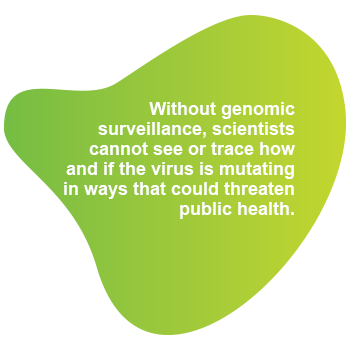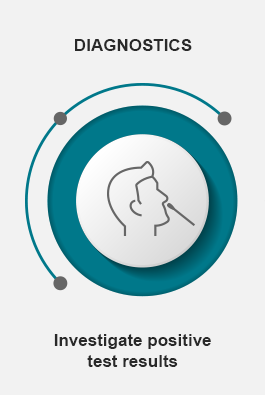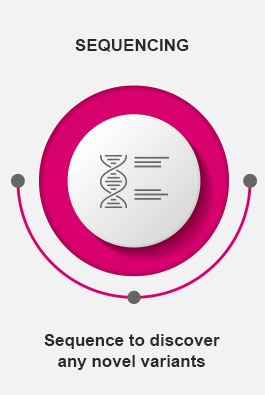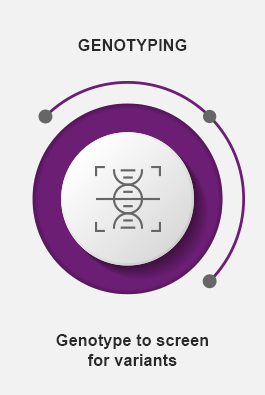Originally published : Fri, April 30, 2021 @ 3:07 PM
Updated : Thu, March 9, 2023 @ 5:37 PM
As the global population gains greater access to vaccines for COVID-19, scientists and health officials continue to closely monitor emerging SARS-CoV-2 variants. While the vaccines are hoped to reduce the spread of the virus, there is also concern that emerging mutations will confer resistance to immune responses raised against strains used as vaccine targets. SARS-CoV-2 variants are already documented throughout the world. Researchers are using the genetic information from these variants in various ways, including assessing viral drug resistance, immune escape and pathogenesis.1 Characterising novel SARS-CoV-2 variants is also critical for developing new vaccines, antiviral drugs and diagnostic assays and informing public health initiatives.
To mitigate the impact of additional waves of infection, avoid lockdowns and save lives, public health organisations must go beyond diagnostic testing to understand the virus’s evolution and track the regional impact of variants. Effectively monitoring emerging variants requires a specific workflow that includes diagnostic PCR testing, genome sequencing and genotyping.
What is a SARS-CoV-2 variant?
A SARS-CoV-2 variant has definitive mutations that differentiate it from the reference sequence and other variants in circulation. Comparing genetic differences between viruses helps us understand how variants relate to each other. Tracking variants is effective in understanding both local disease outbreaks and national trends.2 While many mutations may have little effect on how the virus replicates and infects people, some can be problematic from a public health perspective. For example, the Centers for Disease Control (CDC) outlines critical characteristics that indicate that a mutated virus strain has become a variant of concern. There is evidence to suggest that some of these variants can spread more easily, cause more severe disease, or have the ability to escape the body’s immune response.2
 What is genomic surveillance?
What is genomic surveillance?
Scientists and medical professionals who have access to state-of-the-art technology have contributed to the identification and characterisation of variant virus strains. The term “genomic surveillance” describes the process by which the random variations in a virus’s genetic material are traced over time. Monitoring variants can create a genetic “fingerprint” that can be useful in tracing the evolution of a virus across time and geographies. In turn, that information helps drive more targeted public health measures. Global genomic surveillance is vital for monitoring changes in a virus’s transmissibility, virulence, disease pathology and understanding the impact on the efficacy of diagnostic tests, therapeutics and vaccines.3 Without genomic surveillance, scientists cannot see or trace how and if the virus is mutating in ways that could threaten public health.
Globally, governments are investing in ramping up genomic surveillance programs for SARS-CoV-2. The US CDC plans to invest nearly $200 million to identify, track and mitigate emerging strains of SARS-CoV-2 through genome sequencing. This investment will increase CDC’s sequencing more than threefold from about 7,000 samples per week to approximately 25,000.4 Increasing the number of sequenced samples will improve the ability to detect emerging variants and understand their spread with greater precision.
Similarly, the UK government invested £20 million ($27 million) to launch the COVID-19 Genomics UK (COG-UK) consortium, which co-ordinates the collection of genomic surveillance data from public health labs. The consortium also tracks viral genetic samples from health clinics, university research labs, and public health research facilities to generate a close-to-real-time snapshot of how the virus is changing in the country.5 By the end of January 2021, the consortium had sequenced 200,000 samples and identified worrying mutations in critical genes. As of February 2021, the team sequenced, on average, 10,000 samples per week; eventually, it hopes to increase that number to 30,000 per week.6
How is genomic surveillance of SARS-CoV-2 executed?
There are three approaches to identify and characterise SARS-CoV-2 variants: diagnostic testing, sequencing and genotyping.

Diagnostic testing
Expanded clinical testing is critical to identify SARS-CoV-2 variants. Once a positive test result is obtained, further investigation can reveal important information about the virus’s genome. Supporting data, including details on the sample type, patient demographics and travel history, can help identify and track trends in virus evolution.
SARS-CoV-2 variants pose a concern for public health because they could reduce diagnostic testing sensitivity or cause false-negative results. False negatives could happen if there is a mutation in the virus’s genome within one of the target areas for the PCR test. Using multiple targets for SARS-CoV-2 detection, such as a multiplex PCR test for two or more regions of the virus genome, is a cost-effective approach to reduce the risk of false negatives due to variant virus strains.7

Sequencing
Genomic sequencing of positive SARS-CoV-2 samples is used to identify both novel and known variants. Whole genome sequencing (WGS) reveals a deeper understanding of the spread of variants, determining when the variant may have arisen or the number of times it may have independently emerged. If the virus presents itself in a new way in a patient, sequencing can help evaluate changes in transmissibility or disease severity.
Genomic sequencing helps to guide the public health response to a pandemic. Globally, more than 60,000 near-complete viral genomes were sequenced within the six months following the identification of SARS-CoV-2.7 The World Health Organisation (WHO) recommends increasing worldwide capacities for SARS-CoV-2 genetic sequencing. It encourages the rapid sharing of sequences and metadata to strengthen monitoring of virus mutation acquisition and advance global understanding of variants and their effects on vaccines, therapeutics and diagnostic efficacy.8 Since January 2020, GISAID, a global initiative for sharing virus data, has aggregated nearly 1,500,000 SARS-CoV-2 genomes, enabling partner organisations to track changes in the virus’s genome that could cause concern for public health.9
The number of genomes that the US shared in the online genome repository GISAID in March of 2021 represents only 1.6% of its positive COVID-19 cases for that month.10 The country must reach about 23,000 sequences per week to sequence 5% of all cases, a benchmark considered sufficient to detect emerging variants.11 By comparison, the United Kingdom has sequenced 214,000 genomes — almost 6 percent — of the country’s 3.7 million cases.12
Genotyping
After identifying a variant and associated mutations via sequencing, the data is then used to inform the design of genotyping assays. When novel variants are found via sequencing, the information informs design of PCR genotyping assays. Once the diagnostic test detects a positive sample, further monitoring via genotyping can determine if the strain in question is a known variant. PCR-based genotyping is a cost-effective, high-throughput technique to monitor for variants. Genotyping is a standard, well-accepted practice and generally does not require additional equipment or resources to perform. It is a crucial step for determining how the SARS-CoV-2 virus is evolving in specific geographies over time and is helpful for developing targeted public health responses.
The process involves running primer/probe assays for the qualitative detection of specific SARS-CoV-2 mutations. Using information derived from sequencing projects, the mutations are compared to the defined variant genotypes.
Our commitment to genomic surveillance workflows
LGC, Biosearch Technologies™ is dedicated to supporting genomic surveillance initiatives for managing the COVID-19 pandemic. The breadth of our portfolio allows medical professionals and scientists to execute genomic surveillance workflows, from diagnostics to sequencing and genotyping. Customers can conveniently source all of the required tools and technologies from us to take advantage of our resilient supply chain that’s fortified by our vertically integrated manufacturing platform and global presence. Our expert team of scientists closely monitors SARS-CoV-2 mutations to ensure accurate results and maintain efficacy for the diagnostic assays and also designs specific assays to target emerging mutations.
We’re proud to offer a comprehensive solution that supports testing, sequencing and genotyping of SARS-CoV-2 samples.
Diagnostics
- Biosearch Technologies SARS-CoV-2 Real-Time and End-Point RT-PCR Test, a fully automated high-throughput testing system granted Emergency Use Authorisation (EUA) by the US FDA.
- Biosearch Technologies SARS-CoV-2 ultra-high-throughput End-Point RT-PCR Test, currently under review for emergency use.
Sequencing*
Genotyping*
Assay validation*
*For Research Use Only. Not for use in diagnostic procedures.
References
- Pachetti M, Marini B, Benedetti F et al. Emerging SARS-CoV-2 mutation hot spots include a novel RNA-dependent-RNA polymerase variant. J Transl Med 18, 179. Published 2020. Accessed April 20, 2021. https://doi.org/10.1186/s12967-020-02344-6
- Centers for Disease Control. SARS-CoV-2 Variants of Concern. Published 2021. Accessed April 20, 2021. https://www.cdc.gov/coronavirus/2019-ncov/variants/variant-surveillance.html
- Collins, F. Genome Data Help Track Community Spread of COVID-19. National Institutes of Health website. Published 2020. Accessed April 23, 2021. https://directorsblog.nih.gov/2020/07/21/genome-data-helps-track-community-spread-of-covid-19/
- U.S. White House. Fact Sheet: President Biden Announces New Actions to Expand and Improve COVID-19 Testing. Published 2021. Accessed April 20, 2021. https://www.whitehouse.gov/briefing-room/statements-releases/2021/02/17/fact-sheet-president-biden-announces-new-actions-to-expand-and-improve-covid-19-testing/
- Resnick, B. Covid-19 variants: The US Needs More Genetic Surveillance of the Coronavirus. Vox.com. Published 2021. Accessed April 22, 2021. https://www.vox.com/science-and-health/22225012/us-sequencing-covid-19-variants
- Howes L. 200,000 and Counting: How the UK Has Sequenced So Many Cases of Coronavirus. Chemical and Engineering News. Published 2021. Accessed April 25, 2021. https://cen.acs.org/analytical-chemistry/sequencing/200000-counting-UK-sequenced-cases/99/web/2021/02
- World Health Organization. Operational Considerations To Expedite Genomic Sequencing Component of GISRS Surveillance of SARS-CoV-2. Published 2021. (WHO/2019-nCoV/ genomic_sequencing/GISRS/2021.1). Licence: CC BY-NC-SA 3.0 IGO.
- World Health Organization. Statement On the Sixth Meeting of the International Health Regulations (2005) Emergency Committee Regarding the Coronavirus Disease (COVID-19) Pandemic. Published 2021. Accessed April 18, 2021. https://www.who.int/news/item/15-01-2021-statement-on-the-sixth-meeting-of-the-international-health-regulations-(2005)-emergency-committee-regarding-the-coronavirus-disease-(covid-19)-pandemic
- Haussler D. Share Pandemic Sequences Openly and Fast. Nature. 591, 202. Published 2021. Accessed April 25, 2021. https://www.nature.com/articles/d41586-021-00569-z
- Maxmen A. Why US Coronavirus Tracking Can't Keep Up With Concerning Variants. Nature. 592. 336-337. Published 2021. Accessed April 20, 2021. https://doi.org/10.1038/d41586-021-00908-0
- Vavrek D, Speroni L, J. Curnow K, et al. Genomic Surveillance At Scale Is Required To Detect Newly Emerging Strains At An Early Timepoint. medRxiv. Published 2021. Accessed April 18, 2021. https://doi.org/10.1101/2021.01.12.21249613
- Wan W, Guarino B. Genetic Sequencing: US Lags Behind In Key Tool Against Coronavirus Mutations. Washington Post. Published 29 January 2021. Accessed April 21, 2021. https://www.washingtonpost.com/health/2021/01/29/genetic-sequencing-mutations-coronavirus/


